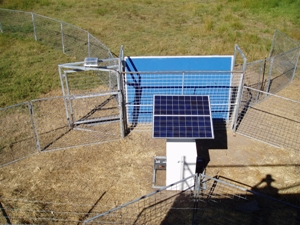Farmers use IT to protect water from ferals

Researchers from two Queensland universities have just finished a working prototype to separate farm animals from their wild counterparts, making sure only livestock and not feral animals or wildlife can drink and eat from farm water supplies and feed.
The system, thought up by Neal Finch from the University of Queensland and Mark Dunn from the University of Southern Queensland, uses solar panels, a mini computer and a webcam to recognise and split up the animals.

The gate set up with the blue backdrop. The white box under the solar panels has the laptop, regulator and webcam inside.
(Credit: Neal Finch)
Once farmers have fenced off the watering hole or feeding station, the system — a gate monitored by a camera and connected to software which only lets livestock and not feral animals through — can do its work.
Currently, the software — which analyses webcam footage to work out the outline of an animal approaching the gate and determine its species — is run on a Windows laptop and powered by two 80W solar panels.
Farmers can also opt to have an RFID tag reader built into the set-up, allowing them to track which of their tagged animals are coming to water or feed. The system can be linked up to the farmers' homestead using off the shelf wireless technology or UHF radio for remote monitoring.
The team is working on an embedded system with an ARM9 processor and monolithic architecture dedicated to running the video processing. According to the academics, such a set-up will be more efficient — run using a 20W solar panel the size of an A4 sheet of paper — and considerably cheaper.
Inside the white box
(Credit: Neal Finch)
Currently, the gate system including the computer and solar panels, costs around AU$10,000.
The device has also been used to keep things in — trapping feral animals. On one farm where they implemented the gate system, the farmer caught 300 feral goats in three days. "At AU$30 a head, that pays for the system," Finch said.
The duo have entered an agreement with Rural Pacific Marketing (RPM) which has the licence to produce and market the product.
"We have a unit that can do the job now — we need the producers to be using these and give feedback," Finch said. "Now's the time to get them out there and get some feedback."
Alix Turner, chairman of the NSW Farmers' Association Wool Committee, said the benefits of such a device would depend on whether the farm had fixed water points, with a farm needing to be running at a relatively high profit to justify the outlay.